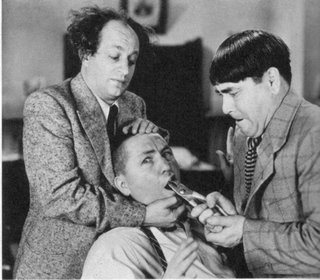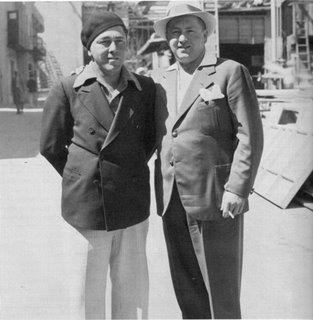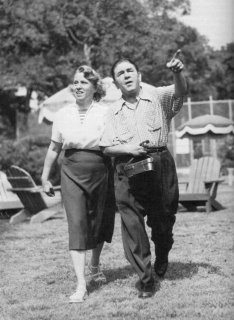
by Nick Zegarac
Moe – “Are you kidding? We’re the best in the city!”
Larry – “But how are you in the country?”
The break between Ted Healy and The Three Stooges proved the beginning of one of the most successful comedy acts in film history. It also became the focus of a minor snafu in contract disputes. Signed by agent Walter Kane for Columbia Studios, studio president Harry Cohn agreed to produce one two-reel comedy featuring the stooges for which they would be paid a poultry sum of $1500.00. Under Healy’s control the boys had barely collected$100.00 per week. If the results proved a success with audiences, Cohn would sign the trio to a long term contract.
Moe signed the Columbia deal on behalf of the act. Unfortunately, across town at Universal, Larry was
 signing a similar deal with agent, Joe Rivkin. The wrangling between Carle Leammle Jr. (Universal’s president) and Harry Cohn was amicably resolved when Cohn discovered that he had signed their contract by only a few hours advance of the Universal deal. “You boys belong to Columbia,” Cohn told Moe.
signing a similar deal with agent, Joe Rivkin. The wrangling between Carle Leammle Jr. (Universal’s president) and Harry Cohn was amicably resolved when Cohn discovered that he had signed their contract by only a few hours advance of the Universal deal. “You boys belong to Columbia,” Cohn told Moe.Man - "This bed goes back to Henry the 8th."
Curly - "That's nuthin'. We had a bed that went back to Sears Roebuck the 3rd."
In June of 1934 The Three Stooges debuted in their first Columbia two-reel comedy; the musically rhymed Woman Haters written and directed by Archie Gottler.

On the strength of that short subject, Harry Cohn agreed to a long-term contract at seventy-five hundred per film and also to produce a pet project of Moe’s: ‘Punch Drunks.’ However, the Columbia deal did come with stipulations.
The first, allowed the studio to re-release the Stooges shorts without royalties paid to them. This did not mean much to the trio in 1934, but with the advent of their loan out two decades later to television a vast amount of potential earnings was denied for years to come.
Also, the Columbia deal came with a yearly renewal clause at which time the studio could simply decided to cancel their option. Columbia used this clause as a means of keeping demands for salary increases down. Every time a request came around Cohn would lament how difficult it was becoming to sell two-reelers to theaters. In reality, Columbia was exploiting the popularity of the trio to market inferior B-movies to theater owners. It would be 24 years, 194 short subjects and 5 feature films later, before Columbia would allow their option on the act to lapse.
Woman - “Do you know of the Great Wall of China?”
Curly - “No. But I know of a big fence in Chicago.”
The Columbia contract also allowed the stooges a yearly twelve week hiatus during which time they could freelance. It was during their 1935 Children’s Hospital benefit performance in Boston that the trio learned of Ted Healy’s untimely death. According to reports of the day, after lashing out in a drunken brawl and being beaten by four men outside of a nightclub, Healy was taken back to his apartment by friend and comedian Joe Frisco where he died a few days later of a brain concussion.
During the next few years The Three Stooges became an intercontinental rage, playing sold out performances at London’s Palladium, The Royal Theater and appearing in the 1939 run of George White’s Scandals on Broadway. They also toured the army/navy circuit during the war, entertaining the troupes on behalf of the Coca-Cola Company and signed a deal to appear in Harold Minsky’s new Vaudeville revival – a short lived venture made all the more brief by the advent of television.
Executioner - “You may either have your head cut off or be burned at the stake.”
Larry – “Cut my head off.”
Curly – “Not me! I wanna be burned at the stake.”
Larry – “Why?”
Curly – “A warm stake is better than a cold chop.”
All The World’s A Stooge...or Three

To say that the late thirties and early forties were a time of prosperity for The Three Stooges is contextualizing their popularity without a sincere grasp on just how wildly popular the trio had become.
They had weathered a rough series of misfires to become the most celebrated of slapstick artists and the upswing of that career had yet to plateau. For a while, this endless tenure of revolving workload proved lucrative and satisfying. But on May 4, 1946, while relaxing between takes in a very humid soundstage, Curly Howard suffered a debilitating stroke.

Confined to the Motion Picture Country Home in Woodland Hills for care and treatment, Moe Howard regrouped the act with Shemp Howard replacing Curly. Since the early thirties, Shemp had had a modestly successful film career playing a cameo comic foil. Still, with Curly’s reputation so heavily ingrained in the act, many in the industry, including Columbia president Harry Cohn and Moe feared that audiences would never accept anyone as Curly’s replacement. Debuting the new stooges with the modestly budgeted Fright Night (1946) Moe and Columbia soon discovered that Shemp’s own brand of comedic genius was more than adequate to sustain the laughter and repartee with audiences.
The fifties was a lucrative period for The Three Stooges professionally– but a decade marred by two tragic losses that devastated the act and the artistic community. Curly Howard, who had never fully recovered from his initial stroke, suffered a series of additional strokes and suddenly passed away on January 1952 at the age of forty-nine. However, an even more disheartening blow followed a scant three years later. On Nov. 23, 1955, Shemp Howard was returning from an outing at the races and the fights with several friends when he suddenly slumped over, and with a queer sort of peaceful smile on his face, inexplicably died.

Shemp’s replacement in the act was Joe Besser, a main staple comedian on Milton Berle’s television show. But the association between Besser and the stooges proved all too brief. After only 16 short subjects, the Columbia contract was fulfilled and Besser, unable to go on tour because of his ailing spouse, was exchanged for Joe DeRita – ironically Moe’s first choice after Shemp’s death who had been under contract to Harold Minsky all along.
Unfortunately, by this time in his career, the determination that had fueled Moe’s earlier aspirations for the act had begun to fizzle. A nightclub debut of the new stooge proved an unqualified disaster. However, at roughly this same interval, Columbia Pictures had managed a minor coup in repackaging the old Stooges shorts for general release on television. These shorts created a minor sensation for children and teens who had never seen them in their original theatrical engagements and helped to revitalize interest in the
 act. During the summer of 1958, the stooges proved a star attraction at John Bertera’s Pittsburgh nightclub and restaurant.
act. During the summer of 1958, the stooges proved a star attraction at John Bertera’s Pittsburgh nightclub and restaurant.This revitalization continued with three guest appearances on the Ed Sullivan and Steve Allen shows. Almost overnight, the stooges were in vogue once more, appearing as a cameo bit of comic relief for Francis Langford and even starring in their own Three Stooges Scrapbook (1960) for Columbia’s Screen Gems. Columbia also cast the stooges in their first feature length film, Have Rocket Will Travel (1961).
Their final feature, The Outlaws Is Coming (1965) ended on a b
 itter note. Larry suffered a stroke and was hospitalized at the Motion Picture Home. Though he made valiant attempts to regain his mobility, his recovery was never complete and on New Years day 1975 he slipped into a coma. He died one week later. Officially retired, Moe allowed Joe DeRita to pursue the idea of recasting his part and Larry’s in a ‘new’ ‘new’ stooges act that never materialized beyond the preliminary stages.
itter note. Larry suffered a stroke and was hospitalized at the Motion Picture Home. Though he made valiant attempts to regain his mobility, his recovery was never complete and on New Years day 1975 he slipped into a coma. He died one week later. Officially retired, Moe allowed Joe DeRita to pursue the idea of recasting his part and Larry’s in a ‘new’ ‘new’ stooges act that never materialized beyond the preliminary stages.Tired and seemingly with his best days behind him, an invitation from Salem College in West Virginia afforded Moe Howard the opportunity to present reminiscences about the act to a live audience; one that proved so popular that he repeated it at New York State University to a packed 1,600 auditorium that had oversold the venue by at least 400 seats. In his seventies, Moe Howard discovered that he was more popular than ever. He appeared on Mike Douglas’ talk show three times and ambitiously pursued the college lecture circuit throughout 1974. On May 4, 1975, Moe Howard quietly passed away at his home, officially ending one of America’s most legendary comedy acts.

Since that time, The Three Stooges popularity has continued to thrive. The trio’s body of work has weathered attempts at censuring its ‘crass’ treatment of women by liberal feminism and it has withstood repeated onslaughts of censorship from civic minded groups who continue to find the stooges brand of comedy too violent yet at the same instance do not mind if their children watched the evening news.
From television revivals, through changing audience tastes and with the advent of home video and garish colorizations, the comedic legacy of The Three Stooges continues to delight old and new audiences with their rambunctious blend of raw energy and good spirited craziness. The legends have gone, but their laughter lives on.
Not bad for the ugliest duckling in the Howard house…not bad at all.
@Nick Zegarac 2006 (all rights reserved).
No comments:
Post a Comment